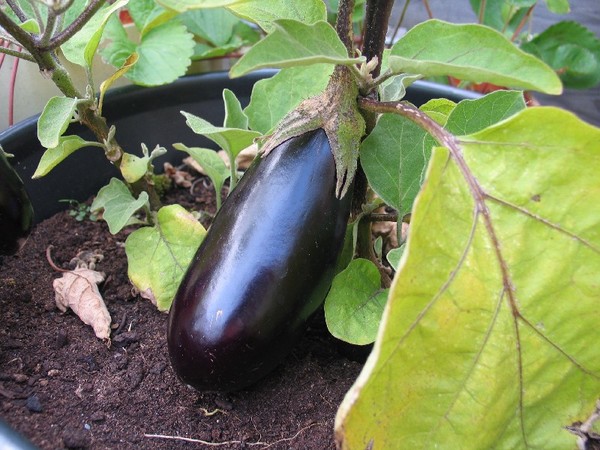 An experienced gardener in appearance of eggplant bushes will be able to extract a lot of useful information about the health and needs of plants. By the condition of the leaves, one can judge the conditions of detention, errors in care, nutrition, diagnose diseases and detect pest damage.
An experienced gardener in appearance of eggplant bushes will be able to extract a lot of useful information about the health and needs of plants. By the condition of the leaves, one can judge the conditions of detention, errors in care, nutrition, diagnose diseases and detect pest damage.
One of the most common eggplant problems - yellowing and wilting of leaves can appear due to several reasons.
The reasons for the yellow color of the leaves
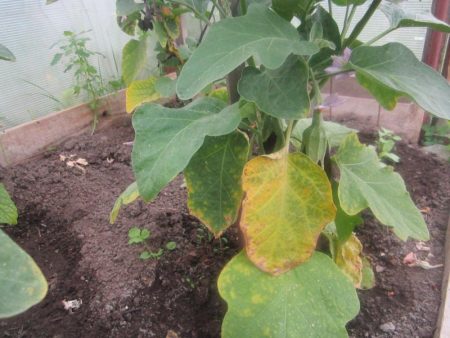 Yellowing eggplant leaves can be a natural response to the stress a plant experiences under new conditions. If the leaves change color to a yellow tint shortly after planting in the greenhouse, most likely there is no cause for concern - after about 2 weeks the acclimatization process will end and the bushes will return to their healthy appearance. In other cases, the yellow color of the leaves is a symptom of pathological processes that require actions by the gardener to restore plant health.
Yellowing eggplant leaves can be a natural response to the stress a plant experiences under new conditions. If the leaves change color to a yellow tint shortly after planting in the greenhouse, most likely there is no cause for concern - after about 2 weeks the acclimatization process will end and the bushes will return to their healthy appearance. In other cases, the yellow color of the leaves is a symptom of pathological processes that require actions by the gardener to restore plant health.
Growing conditions
In many ways, the condition of the bushes and the future eggplant harvest determines the quality of care and the availability of conditions necessary for the normal development. Yellowing and wilting of leaves in plants can provoke:
Wrong watering
With a lack of moisture, the plant does not send nutrients to the leaves, concentrating them in the more "important" parts - roots, stem, flowers, fruits. In this case, the leaves turn yellow and wilt due to starvation. Withering and falling of leaves can also be the result of decay of the root system due to excessive waterlogging of the soil or watering with cold water.
Unsuitable soil
Symptom can occur in eggplant growing on heavy and poor soils with high acidity. The worst option is peaty soils. Plants love loose, well-aerated soils.
Suboptimal temperatures
A sharp temperature drop and its increase to + 30 ° C are detrimental to eggplants. In both cases, the leaves of the plants may turn yellow and lose their elasticity. At the same time, “dry” and hot air, when the high temperature is due to sunny and hot weather, and excessive humidity, when the temperature increase is associated with a lack of ventilation in the greenhouse, are harmful to the “blue ones”.
Bad light
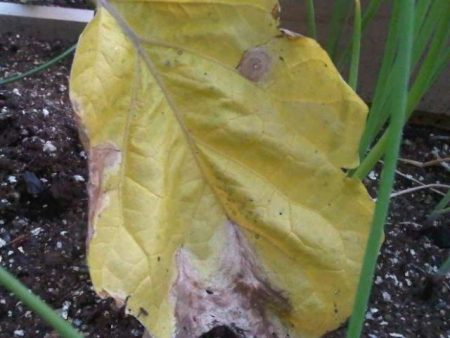 Indoor culture often suffers from a lack of light. Yellowing of the leaves can also be a consequence of burns, including from phytolamps used to make up for the lack of sunlight.
Indoor culture often suffers from a lack of light. Yellowing of the leaves can also be a consequence of burns, including from phytolamps used to make up for the lack of sunlight.
Eggplant should not be planted in the area where tomatoes, peppers or potatoes were grown last season. After these crops, the soil must be restored for at least 3 years before eggplant can be grown in this place. The best place for planting eggplants is the former beds of cabbage, cucumbers, legumes, perennial herbs.
Diseases and Pests
The impact of pests and pathogens also affects the appearance of plants, including their foliage. Yellowing and wilting of leaves in eggplants is one of the symptoms of diseases such as:
Fusarium wilt
A fungal disease in which a symptom appears on the lower leaves.Fusariosis affects the inside of the plant, disrupts the functioning of blood vessels, preventing the spread of nutrients to tissues and causing intoxication. Most often, the disease leads to the death of the bush, but in some cases the bush can continue to grow (but slowly) and even give a small number of small fruits. Fusarium provoke: excess irrigation, increased soil acidity and high temperatures (+ 25 ... + 28 ° C).
Verticillus wilting
It manifests itself, as a rule, during the formation of fruits. At first, leaf segments on the lower tier of the bush turn yellow, then brown spots with a yellow rim appear on the leaf plates. The disease affects the blood vessels of the plant, obstructing the movement of juices. The causative agent is a fungus, activated when there is a lack of watering and temperatures around + 16 ... + 20 ° C. The disease often appears when excessive doses of nitrogen are introduced in the form of root top dressing with organics (manure is primarily dangerous).
Mosaic
A viral disease that often affects eggplants in greenhouses due to a lack of light. Another factor provoking the disease is a decrease in air temperature. On the leaves, spots of lighter and darker shades of green are formed, later the leaves turn yellow. The main consequence of the disease is fetal growth arrest. Ripe eggplants have lignified flesh.
Of the pests that can infect eggplant, yellowing and wilting of leaves causes a spider mite. Accumulations of small parasites that visually resemble the dust that sprinkled a leaf plate can be found on the back of the lower leaves. If ticks have settled on plants for a long time, you can also see a cobweb entangling the leaf there. In the initial stage of the lesion, discolored dots appear at the sites of the insect's prokusov, later the sheet becomes covered with bright spots, curls, turns yellow and fades. The activity of the pest causes a slowdown in the growth of the bush.
Nutrient deficiency
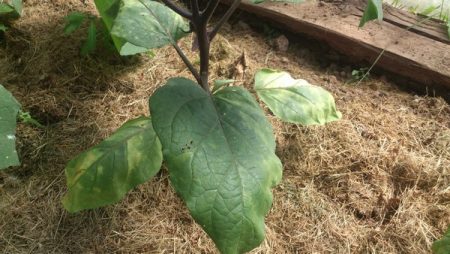 Eggplant can react with yellowing of leaves to a lack of nutrition of many elements, but most often a symptom indicates a deficiency:
Eggplant can react with yellowing of leaves to a lack of nutrition of many elements, but most often a symptom indicates a deficiency:
- Nitrogen In this case, the first thing yellow and fade lower leaves on the bush. Nitrogen is responsible for the distribution of nutrients between parts of the plant, its lack violates the metabolic mechanism. As a result, the leaves do not receive the necessary nutrition and wither.
- Potassium. In addition to yellowing of the leaves, the deficiency is manifested in poor flowering of bushes, drying of the edges of the leaves, the formation of spots on the fruits.
- Magnesium The lower leaves brighten, acquiring a yellowish color, while the veins on them retain a dark green hue.
- Manganese. Signs of an element deficiency are similar to symptoms of a leaf mosaic disease.
Not only bad predecessors, even planting eggplant for two years in a row at the same place, greatly depletes the soil, depriving it of those nutrients that are most needed by the plant. If it is impossible to change the location of the beds, annual enrichment and improvement of the soil is required before planting.
Fix yellow leaf problems
The yellow leaves in eggplant are not a disease, but a symptom of a certain pathological process, so there are no general treatment measures in this case. It is required to eliminate the negative impact and take measures to eliminate its consequences.
Mitigation
If the reason for the yellowing of the leaves lies in improper agricultural technology, in addition to correcting it, you need to support the strength of the plant, help it cope with stress. In this case, it is recommended to make one of the foliar top dressings:
- boron - dilute 5 g of boric acid in a small amount of hot water (+ 50 ... + 55 ° C), after dissolution, dilute with 10 liters of cold water;
- yeast - dilute 10 g of dry yeast in a bucket of warm water, let it brew for 2 days, dilute 1 part of the solution with 10 parts of water before spraying.
Disease treatment
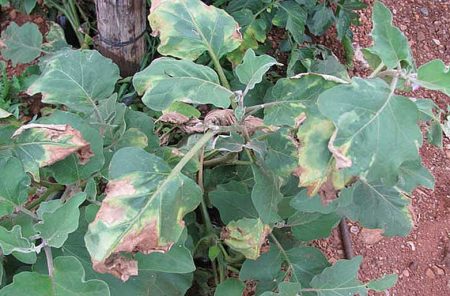 Fusarium spreads quickly by planting eggplant, so it is important to remove the affected areas of plants and all weeds from the site. Plant residues must be burned to prevent the spread of fungus. After that, the planting is treated with fungicides. Suitable "Fundazol", "Benazol", "Consento".
Fusarium spreads quickly by planting eggplant, so it is important to remove the affected areas of plants and all weeds from the site. Plant residues must be burned to prevent the spread of fungus. After that, the planting is treated with fungicides. Suitable "Fundazol", "Benazol", "Consento".
Verticillin wilting is even more dangerous for eggplant; removal and burning of diseased bushes is recommended. The rest of the plants must be treated with the preparations “Vitaros”, “Consento”, “Topsin-M”, “Previkur”.
Both diseases can not be cured with folk remedies, but regular treatment of uninfected plants will help restrain the spread of fungus in the bed with eggplant. The most effective folk remedies against fusarium and verticillosis:
- Milk serum. One part of whey (sour milk) must be diluted with a similar volume of water. Insist 12 hours, strain.
- Yeast. 100 g of live yeast and 100 g of sugar are diluted in 3 liters of warm water. Leave to ferment in a warm place for 2-3 days, stirring occasionally. The finished product is diluted with 10 parts of water.
Effective drugs against viruses do not exist, therefore, the fight against tobacco mosaic is to prevent and remove diseased plants and weeds. Healthy bushes are recommended to be processed with whey.
Spider mite removal
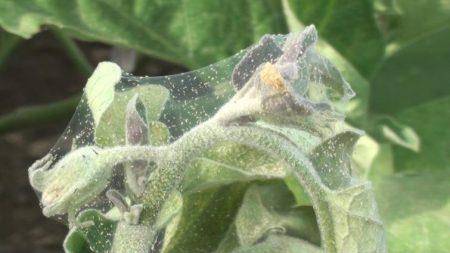 In the fight against spider mites, they try not to resort to chemical insecticides whenever possible. With a small lesion of the pest, it can be effectively eliminated with biological preparations - "Kraft", "Bitoxibacillin", "Tick-borne". The folk remedies are also quite effective:
In the fight against spider mites, they try not to resort to chemical insecticides whenever possible. With a small lesion of the pest, it can be effectively eliminated with biological preparations - "Kraft", "Bitoxibacillin", "Tick-borne". The folk remedies are also quite effective:
- Onion peel. 500 g of husk should be poured with 3 liters of boiling water. It should be insisted 3 days, before spraying - strain.
- Garlic. The teeth from 3 garlic heads need to be crushed and pour 2 liters of hot water. Insist half a day, strain. Before use, the infusion is diluted with 3 parts of water.
- Marigold. A bucket of dried marigold flowers is poured with water and insisted in a dark place for 2 days.
The most effective folk remedies against the spider mite are a soap or alcohol solution (2 tablespoons of 96% alcohol per liter of water), as well as tobacco checkers (for fumigation of the greenhouse).
In the event of an extensive pest defeat, only processing with specialized means will help - Sunmight, Oberon, Actellik, Neoron, Confidor, Flumayt.
Nutritional deficiencies
If the eggplant lacks nutrients, foliar top dressing is necessary. This method ensures that the necessary elements will be obtained by the plant as quickly as possible, plus eliminates possible difficulties in the assimilation of substances due to soil characteristics or growing conditions.
| Element | Feeding Agent | The volume of the substance per 10 liters of water |
| nitrogen | ammonium nitrate or urea | 4-5 g |
| potassium | potassium sulfate | 6 g |
| magnesium | magnesium sulfate | 1 g |
| manganese | manganese sulfate | 5 g |
Prevention
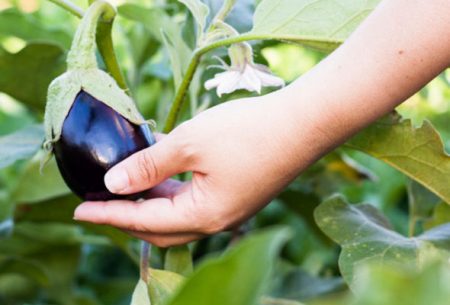 The main measure for the prevention of yellowing of leaves in eggplants is to provide plants with good care. Eggplants quickly respond to gardener's mistakes not only by yellowing the leaves, but also by the fall of flowers and ovaries, the crop can be saved only by providing the plants with all the necessary conditions.
The main measure for the prevention of yellowing of leaves in eggplants is to provide plants with good care. Eggplants quickly respond to gardener's mistakes not only by yellowing the leaves, but also by the fall of flowers and ovaries, the crop can be saved only by providing the plants with all the necessary conditions.
The main measures to prevent the appearance of yellow leaves in eggplant:
- Since it is difficult to maintain crop rotation in the greenhouse, it is worth updating the topsoil once every several years. The ground for eggplant needs to be prepared: liming acidic and loosening heavy soils. As baking powder, you can use sand, ripe sawdust and rotted manure. In peat soil, you need to add compost and turf soil.During the growing season of eggplants, loosening the soil is very useful - this procedure not only provides oxygen to the roots, but also reduces the risk of developing fungal diseases.
- In order for young eggplant bushes to adapt better and faster after planting in the greenhouse, it is necessary to harden the seedlings. Planting plants in a new place should be with an earthen lump, trying not to damage the roots.
- Eggplants need regular and adequate soil moisture. At the initial stage of the growing season, plants are given 10 liters of water per 1m2 once a week, during flowering - 12 liters per square of beds twice a week.
- The difference between the temperatures of the soil and water for irrigation should not be large, otherwise the root system of the eggplant is damaged, decay may begin. Watering with cold water also increases the risk of fungal diseases (anthracnose, powdery mildew, gray rot, copperfish and others).
- In a glass greenhouse, where direct sunlight is available to plants, or in the case of using additional lighting lamps, do not irrigate eggplants by sprinkling to avoid burns. Preferred evening watering.
- At high temperatures, the greenhouse should be often ventilated. For cooling, you can place buckets of cold water between the rows, without forgetting to periodically replace the heated water.
Do not plant eggplants near the entrance to the greenhouse - in this place, the plants are most strongly affected by the temperature difference inside and outside the shelter.
- Prevention of fungal diseases is especially relevant for eggplant in the greenhouse. Pre-sowing treatment of seeds (for example, to withstand seed in a solution of potassium permanganate), disinfection of soil for seedlings, preventive treatment of plants with folk remedies and biological products is recommended. Of the latter, Trichodermin will give a good effect if you put it in the holes for planting seedlings in a greenhouse (but the soil temperature should not be below + 14 ° C, the drug is most effective at + 18 ° C). 10 days after transplanting seedlings into closed ground, the first preventive spraying with fungicides can be carried out. Zinc-based Antracol is suitable.
Yellowing of the leaves can be caused by a complex of reasons, which complicates the diagnosis and the choice of the right treatment measures. Having found a disease or nutritional deficiency, it is necessary to critically evaluate the growing conditions, trying to ensure optimal conditions for the plants. And vice versa, do not rush to give top dressing if agricultural technology is not followed - first of all, it is necessary to improve the conditions. This precaution will prevent excess eggplant nutrition.

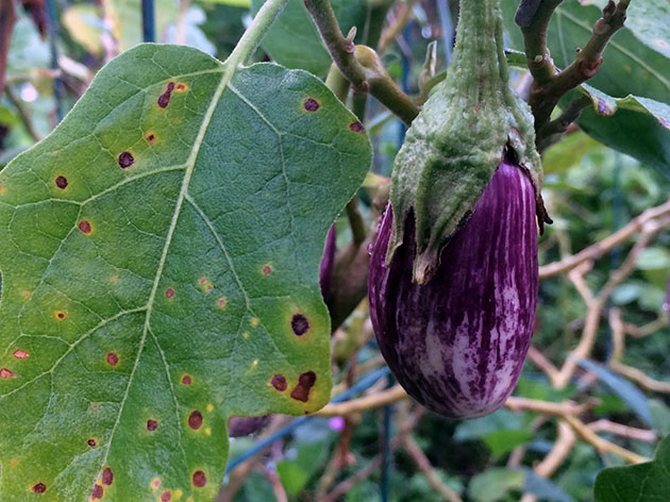
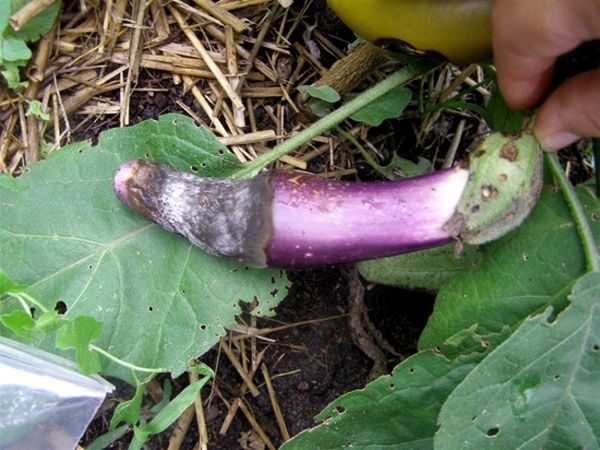
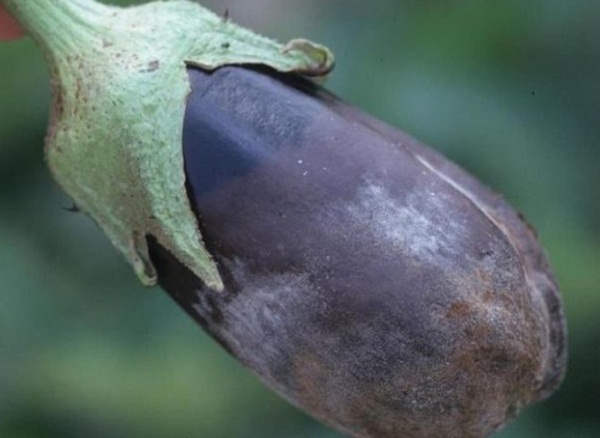
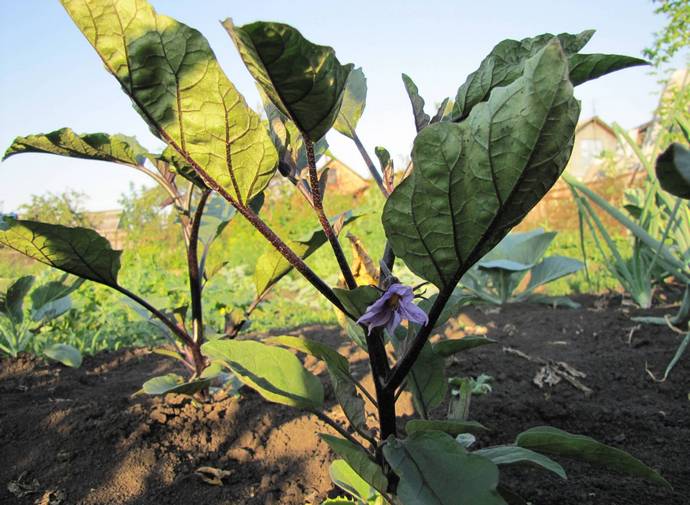 Eggplant have a empty flower? Save together with simple methods
Eggplant have a empty flower? Save together with simple methods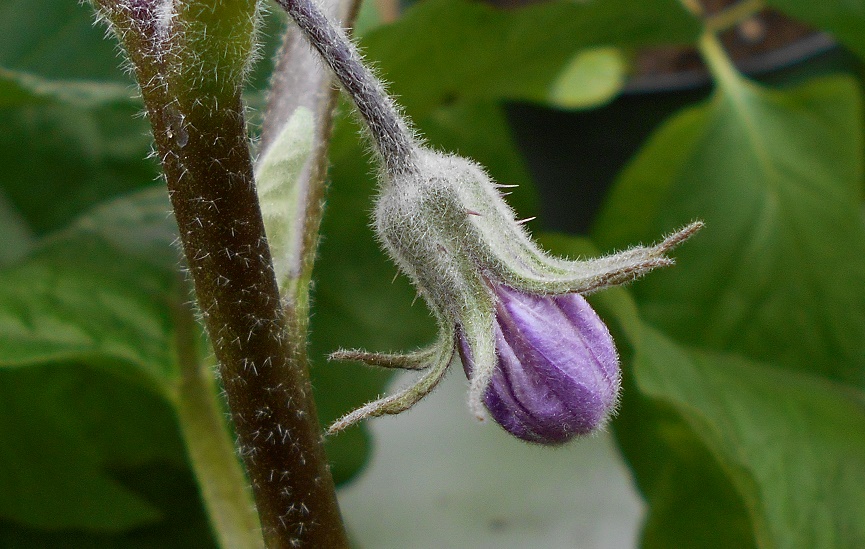 How to help eggplants to prevent flowers falling in the greenhouse?
How to help eggplants to prevent flowers falling in the greenhouse?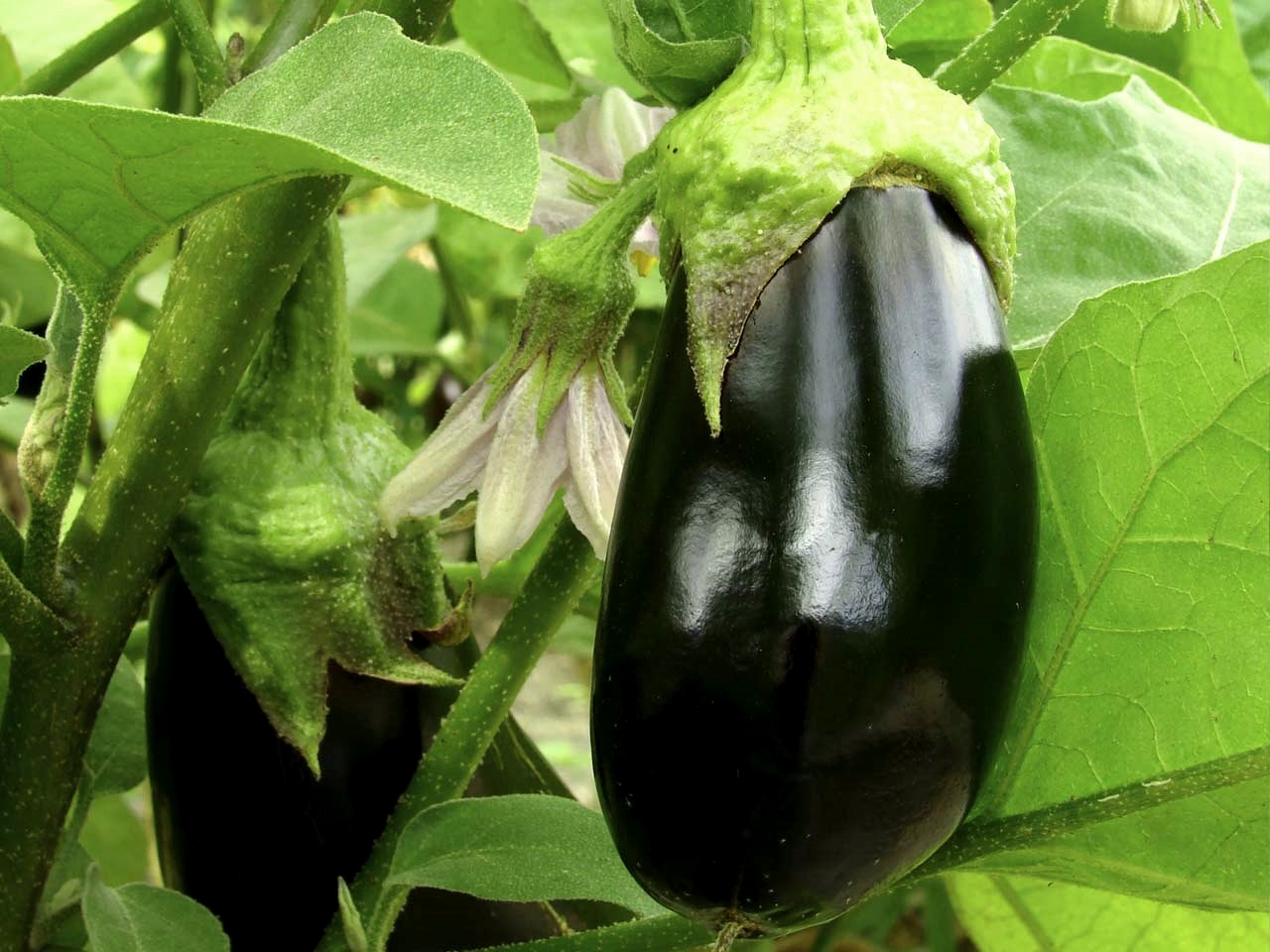 What to do to get a good eggplant crop in a greenhouse
What to do to get a good eggplant crop in a greenhouse